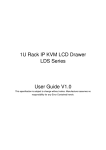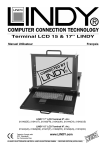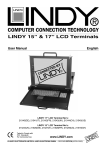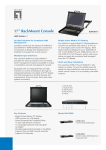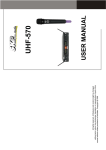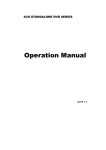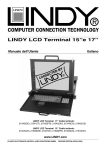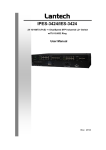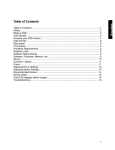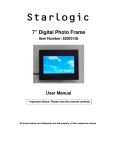Download 1U Rack LCD Drawer LDS Series User Guide Rev. 2.2
Transcript
1U Rack LCD Drawer LDS Series User Guide Rev. 2.2 This specification is subject to change without notice. Manufacturer assumes no responsibility for any Error Contained herein. IMPORTANT SAFETY INSTRUCTIONS 1. Please read these instructions carefully before using the product and save for later reference. 2. Follow all warnings and instructions marked on the product. 3. Unplug this product from the wall outlet before cleaning. Clean the product with a damp soft cloth. Do not use liquid or aerosol cleaners as it may cause permanent damage to the screen. 4. Do not use this product near water. 5. Do not place this product on an unstable cart, stand, or table. The product may fall, causing serious damage to the product. 6. Slots and openings in the cabinet and the back or bottom are provided for ventilation; to ensure reliable operation of the product and to protect it from overheating, these openings must not be blocked or covered. The openings should never be placed near or over a radiator or heat register, or in a built-in installation unless proper ventilation is provided. 7. This product should be operated from the type of power indicated on the marking label. of the type of power available, consult your dealer or local power company. If you are not sure 8. This product is equipped with a 3-wire grounding type plug, a plug having a third (grounding) pin. This plug will only fit into a grounding-type power outlet. This is a safety feature. If you are unable to insert the plug into the outlet, contact your electrician to replace your obsolete outlet. Do not defeat the purpose of the grounding-type plug. 9. Do not allow anything to rest on the power cord. cord. Do not locate this product where persons will walk on the 10. If an extension cord is used with this product, make sure that the total of the ampere ratings on the products plugged into the extension cord does not exceed the extension cord ampere rating. Also make sure that the total of all products plugged into the wall outlet does not exceed 15 amps. 11. Never push objects of any kind into this product through cabinet slots as they may touch dangerous voltage points or short out parts that could result in a risk of fire or electric shock. Never spill liquid of any kind on the product. 12. Do not attempt to service this product yourself, as opening or removing covers may expose you to dangerous voltage points or other risks and will void the warranty. Refer all servicing to qualified service personnel. 13. Unplug this product from the wall outlet and refer servicing to qualified service personnel under the following conditions: a. When the power cord or plug is damaged or frayed. b. If liquid has been spilled into the product. c. If the product has been exposed to rain or water. d. If the product does not operate normally when the operating instructions are followed. Adjust only those controls that are covered by the operating instructions since improper adjustment of other controls may result in damage and will often require extensive work by a qualified technician to restore the product to normal operation. e. If the product has been dropped or the cabinet has been damaged. f. If the product exhibits a distinct change in performance, indicating a need for service. 2 Contents 1. Introduction.......................................................................................................................................... 4 1.1. Overview................................................................................................................................... 4 1.2. Major Features .......................................................................................................................... 4 1.3. Outline Drawing ....................................................................................................................... 4 1.4. Notice........................................................................................................................................ 5 1.5. Check List ................................................................................................................................. 5 2. Configurations and Installation............................................................................................................ 5 2.1. Configurations .......................................................................................................................... 5 2.2. Installation ................................................................................................................................ 5 3. LCD OSD Key Definition ................................................................................................................... 7 3.1. The Control Key Description.................................................................................................... 7 3.2. LCD OSD SCREEN ................................................................................................................. 8 4. KVM (optional) ................................................................................................................................... 9 4.1. KVM OSD Control................................................................................................................. 10 4.2 KVM ON SCREEN DISPLAY OPERATION ........................................................................ 12 5. Specifications..................................................................................................................................... 14 6. Cleaning the Rack Drawer Monitor................................................................................................... 15 7. Disclaimer.......................................................................................................................................... 15 8. Troubleshooting: ................................................................................................................................ 15 9. Appendix:........................................................................................................................................... 16 9.1 Supporting Resolution Modes: ................................................................................................ 16 9.2. Limited Warranty.................................................................................................................... 17 3 1. Introduction 1.1. Overview The LDS series (LDS210D/LDS310D/LDS410D) are a series of compact devices, built-in a 15”, 17” or 19” LCD display, standard keyboard with numerical keypad, and heavy-duty touch pad to eliminate hardware redundancy and to increase cost efficiency. The 1U rack mount is designed to be an ideal solution for saving valuable rack mounting space, while possessing features such as monitor flip up design, adjustable mounting brackets, built-in LCD OSD and an optional centralized control of 8/16 PCs. 1.2. Major Features Item TFT Display OSD Function VGA DVI(optional) Power Consumption(Watts) Power Supply Keyboard and Touch Pad Numerical Key Pad Dimensions Operating Temperature KVM Switch (optional) LDS210D LDS310D LDS410D 15” 17” 19” Built in OSD Screen Adjustment Function 15-pin D-sub RGB Analog Input Signal DVI-D None None 33 38 41 AC 100-240V Universal 88-key Keyboard and Integrated Touch Pad 17-key numerical Key Pad 1U compact design, 517mm (D) x484mm (W) x44mm (H) 0° to 50° C Operating Temperature OSD controlled 8/16 port KVM switch 1.3. Outline Drawing Front Side Mounted on Rack-Mount Chassis Rear Side (1 port) 4 16 15 14 13 12 11 10 9 8 7 6 5 Rear Side (16 port) 4 3 2 1 1.4. Notice 1. Do not touch the LCD panel surface with sharp or hard objects. 2. Please ensure the LCD Drawer is securely in place. The surface for placing and fixing the LCD Drawer should be stable and level or mounted into a suitable cabinet. 3. Ensure there is enough ventilation for the LCD Drawer, as well as out of direct sunlight, away from sources of excessive dust, heat, water, moisture, and vibration. 4. Ensure the location of the LCD Drawer is convenient enough for it to connect to its related facilities. 1.5. Check List Before using this rack monitor, please make sure that all the items listed below are present in your package Analog color LCD Drawer Accessory Box containing: 1. KVM (Keyboard, Video, Mouse) expansion cable ×1 2. Power cable ×1 3. User guide ×1 If any items are missing or damaged, please contact your dealer immediately. 2. Configurations and Installation 2.1. Configurations The LDS serials rack LCD drawer supports 1 computer. The configuration is as shown in following figure. 2.2. Installation Step 1. Mount on Rack-Mount Chassis 5 Mount the Rack Drawer LCD on Rack-Mount Chassis with screws. STEP1 Step 2. Power Cable Connection Connect the power cord to the rack LCD monitor and AC outlet. Step 3. PS2 Mouse, Keyboard and VGA Cable Connection LDS210/310/410 – 1P: ◆ Power down the computer which will be connected to your rack LCD monitor. Plug one end Cable Appearance of the KVM expansion cable to the connectors at the rear of the PC system and the other end to the rack LCD monitor. ◆ Secure the connectors with the screws on the cable connector at both ends. LDS210/310/410 – 8/16P: ◆ Power down all computers which will be connected to your rack LCD monitor. ◆ Plug one end of the KVM expansion cable to the connectors at the rear of all the PC systems and the other end to the rack LCD monitor. ◆ Secure the connectors with the screws on the cable connector at both ends Note: The KVM expansion cable for the LDS210/ 310/ 410 -16P is different from the other KVM switch cables. The end of the KVM switch side is the 15-pin black connector for monitor, keyboard and mouse. The matching port of the KVM switch also uses 15 –pin black ports. Note: All connectors are color coded; blue – video, green – mouse, purple – keyboard 6 Cable Appearance ONE OF YOUR COMPUTER LDS210/310/410-16P 3. LCD OSD Key Definition 1. MENU Use this key to select the function you would like to adjust. 2. ADJUST Use this key to adjust the selected function for optimal viewing. 3. POWER SWITCH Use the power switch to turn the power ON or OFF. then the LCD monitor. We recommend turning your PC system power on first, 4. POWER STAND-BY MODE LED Indicates when the power is in the stand-by mode. 5. Power on LED Indicates when the power is in the ON position. 3.1. The Control Key Description + : Power on/off control. : Call menu / Shifting the selection left. : Call menu / Shifting the selection right. : Decrease value. : Increase value. / Automatic adjustment. 7 3.2. LCD OSD SCREEN - + 100 0 1024x768 H:60.09KHz V:75.12Hz BRIGHTNESS Press "+" to increase or "-" to decrease the brightness. CONTRAST Press "+" to increase or "-" to decrease the contrast. H-POSITION Press "+" or "-" to move the image to the left or right on the screen. V-POSITION Press "+" or "-" to move the image up or down on the screen. H-SCALING Press "+" or "-" to increase or decrease the Horizontal screen size. AUTO ADJUSTMENT Press "+" or "-" to have the monitor logic choose the best settings for the current input signal. WHITE BALANCE Press "+" or "-" to enable auto adjust white balance function. COLOR TEMPERATURE Press "+" or "-" to set the color temperature USER: Use this function to set a proper color temperature. 9300K:Push to set monitor for the CIE coordinate 9300 color temperature 6500K:Push to set monitor for the CIE coordinate 6500 color temperature 5500K:Push to set monitor for the CIE coordinate 5500 color temperature GAMMA Press "+" or "-" to adjust GAMMA Function. PHASE Press "+" or "-" button to adjust the Phase control. Phase adjustment may be required to optimize the display quality. OSD TRANSPARENT Press "+" or "-" to adjust the OSD background color. ADC ADJUST Press "+" or "-" to enter the ADC control manual for Brightness, Contrast, Red Color Gain, Green Color Gain and Blue Color Gain adjustment. CHANNEL Press "+" or "-" to change the input channel RECALL Press "+" or "-" to RECALL the factory default settings. OSD EXIT Press "+" or "-" to EXIT the OSD MENU. 8 Summary BRIGHTNESS: Press "+" or "-" to adjust. CONTRAST: Press "+" or "-" to adjust. H-POSITION: Move the screen to the left or right side. V-POSITION: Move the screen up or down. CLOCK: To adjust the Horizontal screen size. AUTO: To find the optimal screen settings. WHITE BALANCE: White Balance value adjust. COLOR TEMPERATURE: Color Temperature settings. GAMMA: Gamma value adjust. PHASE: Adjust horizontal phase for optimal display quality. TRANSPARENT: OSD Transparent adjustment. ADC CONTROL: Color degree adjustment. CHANNEL: change the input channel RECALL: Press "+" or "-" to reset the factory default settings. EXIT: To exit from the OSD function. 4. KVM (optional) The 1U Rack LCD Drawer build-in KVM Switch enables a single keyboard, video monitor and mouse to control multiple computers at a time. This product supports one console and 8/16 computer ports. Product model number as follow table: LDS210D-8P LCD Size 15” LDS310D-8P 17” 8 LDS410D-8P 19” 8 LDS210D-16P 15” 16 LDS310D-16P 17” 16 LDS410D-16P 19” 16 P/N Computer port number 8 This series KVM switch has an On-screen Display (OSD) menu so that you can operate the system easily. 9 4.1. KVM OSD Control Keyboard Hot Key Commands: You can command KVM switch by switching ports through simple key sequences. To send commands to KVM switch, the “SCROLL LOCK” key must be pressed twice within 2 seconds. You will hear a beep for confirmation and the keyboard is in hot key mode. If you have not pressed any key in hot key mode within 2 seconds (It means to key in any key follows up “Scroll Lock” “Scroll Lock” key ), the keyboard will back to under Operation System control state. Below are the different hot key commands: within 2 seconds Scroll Lock + Scroll Lock + ↑ = Previous Channel Scroll Lock + Scroll Lock + ↓ = Next Channel (Note: You also could press “up arrow key” or “down arrow key” longer time to speed up selecting the destination port) Scroll Lock + Scroll Lock Scroll Lock + Scroll Lock + + Page Up Page Down = = Previous Bank Next Bank To select PC port: Scroll Lock Scroll Lock + + Scroll Lock Scroll Lock + + Bank No 1~8 B Port No 0 or 1 = Port No. 1~8 (8 port) 1~16 (16 port) Beeper (Note: The default Beeper function is ON and beeper control is only for available for Scan Mode ) Scroll Lock + Scroll Lock + S = Auto Scan 10 To get out of Auto Scan Mode, Press any key or SPACE bar. Scroll Lock + Scroll Lock + = R OSD setting back to factory default value (Note: Not including password) ROM Scroll Lock + Scroll Lock F + = REFLASH Search the same PC name st (Note: Search PC name starting from 1 PC port) FIND:█ Scroll Lock + Scroll Lock + Space bar = On Screen Display Menu : Example A. To access a computer attached to Port 4 of the three Bank. You can press through hot key as below: Scroll lock + Scroll lock + 3 + 04 B. To access a computer attached from Bank 3 to Bank 4, You can press through hot key as below: Scroll lock + Scroll lock + Page Down Note: Bank no. and Port no. selection must be made using the numeric keys on the keyboard. Numeric keys on the keypad are not available as a hot key command. 11 4.2 KVM ON SCREEN DISPLAY OPERATION 1. OSD menu can be popped up in powered on PC port or non-powered on PC port or empty PC port. The resolution of OSD menu is fixed to 1024X768 for non-powered on PC port or empty PC port. 2. When you pop up the OSD menu window go through the hot key, you will see the following small window on your monitor. BANK : 1 a. The 1ST line bar is Bank no. SYSTEM 01 02 ☼SYSTEM 02 03 ☼SYSTEM 03 04 ☼SYSTEM 04 05 ☼SYSTEM 05 06 SYSTEM 06 07 SYSTEM 07 08 ☼SYSTEM 08 09 SYSTEM 09 10 11 ☼SYSTEM 11 10 SYSTEM 1 12 ☼SYSTEM 13 SYSTEM 13 14 ☼SYSTEM 14 15 ☼SYSTEM 15 16 16 01 OSD : 1 0 SEC. SYSTEM 12 CHANGE PASSWORD SCAN: 1 0 SEC. CONSOLE ON/OFF ESC : QUIT ENTER :COMPLETE TAB : NEXT INSERT :EDIT b. The 2nd block is your PC system name list. You will find the system number list from 01 to 04 ( if the current box is 4 port) or from 01 to 8 (if the current box no. is 8 port)or from 01 to 16 (if the current box no. is 16 port). You can define your PC name in maximum 8 characters. The factory default of 16 port KVM switch PC name is from “SYSTEM 01”, “SYSTEM 02” ,…, “SYSTEM 16” and 8 port KVM switch is from “SYSTEM 01”, “SYSTEM 02”,…, “SYSTEM 08”. Besides, the sun symbol “ ☼ “ near to the PC name represents the PC system is powered on. / : PORT SELECT PgDn/PgUp: BANK SELECT To use up arrow key “ “ or down arrow key “ “ to select port for destination PC name. After you have selected the PC port already, you can press the ENTER Key to switch the PC port you want immediately To use “ PgUp “ key or “ PgDn” key for selecting previous or next Bank no. (or Box No.) BANK : 1 01 SYSTEM 01 02 ☼SYS█EM 02 To press “ INS” key for editing PC name. After finishing the edit, please press “Enter “key for saving information. 12 To use “ Tab “ key to select items like Bank, OSD, SCAN, CHANGE PASSWORD, CONSOLE ON/OFF, etc… 15 15☼SYSTEM 15 16 SYSTEM 16 OSD : 1 0 SEC. CHANGE PASSWORD SCAN: 1 0 SEC. CONSOLE ON/OFF ESC : QUIT ENTER :COMPLETE TAB : NEXT INSERT :EDIT a. The “OSD: 10 SEC” means that the PC system name exists 10 sec on your monitor. You can modify it from 05 sec to 99 sec. The factory default value is 10 sec. b. The “ SCAN TIME” means that scan interval from one PC port to next PC port. The default SCAN time is 10 sec and the maximum scan time is 99 sec. c. The “ CHANGE PASSWORD” is for user to avoid all PC systems to be intruded by the other person. The default password is 8 digits “ 00000000 “. ENTER PASSWORD : █ ESC : QUIT ENTER : COMPLETE There is an enter password window showed out when you select this item and then press the Enter. The maximum password is eight digits. After you key in the password already and press the Enter key, there is another window for confirming your typed password. ENTER NEW PASSWORD : █ ESC : QUIT ENTER : COMPLETE RETYPE NEW PASSWORD : █ COMPLETE ESC : QUIT ENTER : COMPLETE You need to retype the password again for rechecking your previous key-in password is matched or not. NEW PASSWORD ESC : QUIT COMPLETE COMPLETE ENTER : d. The “ CONSOLE ON/OFF “ means to manage the console of KVM switch. If you select “ CONSOLE ON “, it means that any user can use the console. If you select “ CONSOLE OFF “(factory default OFF state), it means that any user will not be allowed to use the 13 console unless you enter the password. When you enter the password already and pass the KVM switch authentication, the CONSOLE will be set to ON. After you finish using KVM switch, please don’t forget to set up CONSOLE ON state to OFF state. Besides, if current CONSOLE is ON state and you reset KVM switch, the CONSOLE will be set up ON state back to OFF state. e. When you finish the set up of PC name and get out of OSD setting mode, you will find the PC name showed at the up-left corner of monitor. Now, you can use ESC key to clear the message right away if you don’t need it. 102 ☼SYSTEM 02 f. If you want OSD returning back to factory default value, you can execute “SCROLL LOCK”, “SCROLL LOCK” , “R” keys in order. The bank seven segment LED on the front panel will be flashed during the refresh process. ROM REFLASH When the OSD value back to default setting, the bank seven segment LED on the front panel will stop flashing 5. Specifications Item LDS210D LDS310D LDS410D Display Area(mm) 304.1(H) x 228.1(V) 337.9(H) x 270.3(V) 376.3(H) x 301.1(V) (15-inch diagonal) (17-inch diagonal) (19-inch diagonal) Pixel Pitch 0.297(H) x 0.297(V) 0.264(H) x 0.264(V) 0.294(H) x 0. 294(V) Number of Pixels 1024(H) x 768(V) 1280(H) x 1024(V) 1280(H) x 1024(V) Contrast Ratio 350:1 800:1 800:1 Display Color 16.2M colors 16.7M colors 16.7M colors Brightness 250 300 300 (CD/m^2) Backlight Unit 2 replaceable CCFLs 4 replaceable CCFLs edge-light (top/bottom) edge-light (top/bottom) Viewing Angle -65º~65º(H), -70º~70º(H), -85º~85º(H), -50º~55º(V)(Typ.) -60º~60º(V) (Typ.) -85º~85º(V) (Typ.) I/O Power: 12V DC Adapter Keyboard:PS/2 Mouse:PS/2 VGA:15-pin D-sub Keyboard 88-key keyboard and integrated Touch Pad and Key pad 17-key numerical key pad Power 33 Watts 38 Watts 41 Watts Consumption Power Supply AC 100-240V Universal On-Screen Display Contrast, Brightness, H/V Position, H/V Size, H-scaling, Auto-adjust, Color Temp.(9300, 6500, User), Red-Gain, Blue-Gain, Green-Gain, Gamma, Recall, Phase, OSD & Exit Hot Key Control OSD Hot Key Environmental Operating temperature:0ºC~ 50ºC (32 F~ 122 F) consideration Storage temperature:-20ºC~ 60ºC(-4 F~ 140 F) Humidity 10~85% in operating; 10-90% in storage 14 Size 517mm(D) x 484mm(W) x 44mm(H) 6. Cleaning the Rack Drawer Monitor Make sure the rack drawer monitor is turned off. Never spray or pour any liquid directly onto the screen or case. Wipe the screen with a clean, soft, lint-free cloth. This removes dust and other particles. The display area is highly prone to scratching. Do not use ketene type material (ex. Acetone), Ethyl alcohol, toluene, ethyl acid or Methyl chloride to clear the panel. It might permanently damage the panel. If still not clean, apply a small amount of non-ammonia, non-alcohol based glass cleaner onto a clean, soft, lint-free cloth, and wipe the screen Don't let water or oil penetrate the monitor. If the droplets are kept for a long time, Staining and discoloration may occur. 7. Disclaimer We do not recommend the use of any ammonia or alcohol-based cleaners on the monitor screen or case. Some chemical cleaners have been reported to damage the screen and/or case of the rack LCD monitor. Seller will not be liable for damage resulting from use of any ammonia or alcohol-based cleaner. 8. Troubleshooting: Ensure that all cables are well seated. Check that keyboard/mouse cables are not swapped. If your monitor fails to operate correctly, consult the following chart for possible solution before calling for repairs: Condition Check Point 1. The picture does not Check if the signal cable is firmly seated in the socket. appear Check if the Power is ON at the computer Check if the brightness control is at the appropriate position, not at the minimum. 2. The screen is not Check if the signal cable is firmly seated in the socket. synchronized Check if the output level matches the input level of your computer. Make sure the signal timings of the computer system are within the specification of the monitor. If your computer was working with a CRT monitor, you should check the current signal timing and turn off your computer before you connect the VGA Cable to this monitor. 3. The position of the screen Adjust the H-position, and V-position, or Perform the Auto is not in the center adjustment. 15 4. The screen is too bright (too dark). Check if the brightness or contrast control is at the appropriate position, not at the Maximum (Minimum). 5. The screen is shaking or waving Press ”+” (the Auto - adjustment control) to adjust. Moving all of objects which emit a magnetic field such as motor or transformer, away from the monitor. Check if the specific voltage is applied. Check if the signal timing of the computer system is within the specification of monitor. 6. Mouse or Keyboard is not Verify that the mouse or keyboard is correctly plugged in to functioning the KVM switch. (for LDS 210/310/410-8/16P) Verify that the cable is correctly connected between the computer and the KVM switch. Restart the computers. Verify that the keyboard or mouse works when connected directly to the computer. Note: The mouse will be inactive when OSD menu is active. 7. Hotkey selection is not The Hotkey or Push button selection is inactive when the functioning password is active. If you are unable to correct the fault by using this chart, stop using your monitor and contact your distributor or dealer for further assistance. 9. Appendix: 9.1 Supporting Resolution Modes: LDS210D(15”): Mode Mode 1 Mode 2 Mode 3 Mode 4 Mode 5 Mode 6 Mode 7 Mode 8 Mode 9 Mode 10 Mode 11 Mode 12 Mode 13 Resolution 640×350 640×400 640×480 640×480 640×480 720×400 800×600 800×600 800×600 800×600 1024×768 1024×768 1024×768 LDS310D(17”)/LDS410D(19”): H-Freq. (KHz) 31.5 31.5 31.5 37.9 37.5 31.5 35.1 37.9 48.1 46.9 48.4 56.5 60.0 V-Freq. (KHz) 70 70 60 72 75 70 56 60 72 75 60 70 75 Mode Mode 1 Mode 2 Mode 3 Mode 4 Mode 5 Mode 6 Mode 7 Mode 8 Mode 9 Mode 10 Mode 11 Mode 12 Mode 13 Mode 14 Mode 15 16 Resolution 640×350 640×400 640×480 640×480 640×480 720×400 800×600 800×600 800×600 800×600 1024×768 1024×768 1024×768 1280×1024 1280×1024 H-Freq.(KHz) V-Freq.(KHz) 70 31.5 70 31.5 60 31.5 72 37.9 75 37.5 70 31.47 56 35.1 60 37.9 72 48.1 75 46.9 60 48.4 70 56.5 75 60.0 60 64.0 80.0 75 9.2. Limited Warranty In no event shall the direct vender’s liability for direct or indirect, special, incidental or consequential damages, loss of profit, loss of business, or financial loss which may be caused by the use of the product exceeds the price paid for the product. The direct vendor makes no warranty or representation, expressed or implied with respect to the contents or use of this documentation, and especially disclaims its quality, performance, merchantability, or fitness for any particular purpose. The direct vendor also reserves the right to revise or update the product or documentation without obligation to notify any user of such revisions or updates. For further information, please contact your direct vendor. All the brand names and registered trademarks are the property of their respective owners. 17

















